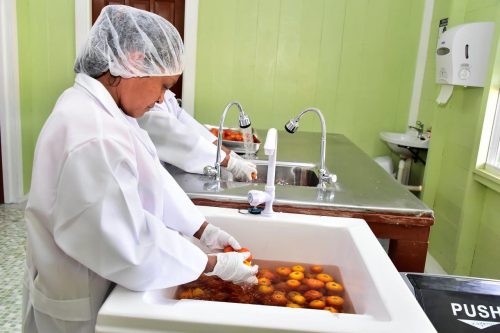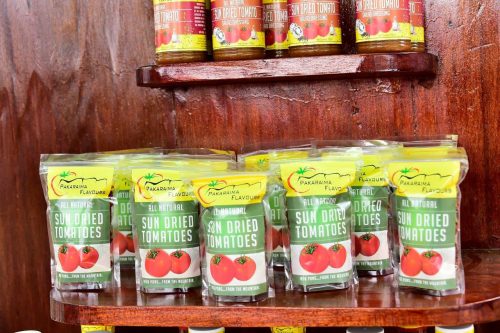President David Granger on Saturday hailed the Paramakatoi Tomato Project Facility, which will produce sun-dried tomatoes, as an ambitious move towards agro-processing and value added production for the Potaro-Siparuni region.
A statement from the Ministry of the Presidency said that he hailed it as a demonstration of Government’s commitment to transforming the economic landscape of the hinterland and the country as a whole. He made the remarks while officially commissioning the project which is a collaborative effort among the Government of Guyana, through the Ministry of Indigenous Peoples’ Affairs (MOIPA), the Institute of Applied Science and Technology (IAST) at the University of Guyana, the National Agricultural Research and Extension Institute (NAREI), the Canadian High Commission in Guyana and the people of Paramakatoi in Region Eight.


“This is the start of a revolution of producing, of bottling, of packaging, of marketing our farming, our fishing products by adding value. We are embarking on a long lasting economic trajectory for the people of this region. When the tide rises all the boats rise with the tide. When we have a rising tide of agricultural production everybody will benefit; the people with transportation would benefit, the airlines would benefit, the school children would benefit, the people, who produce the packaging material would benefit… What is taking place here will make Guyana a better place,” the President exulted.
The statement said that the Project was conceptualised when Minister within the Ministry of Indigenous Peoples’ Affairs, Valerie Garrido-Lowe, following the vision of the Head of State explored opportunities to utilise the fertile soil of the Pakaraimas. The Minister met with IAST Director, Professor Suresh Narine and the proposal was developed. The project, which cost $59M was funded by Government, along with a $5M grant from the Canadian High Commission.
IAST Director, Professor Narine lauded the work done by Garrido-Lowe and Business Minister Dominic Gaskin on their commitment to ensuring the movement of this project from vision to reality. He also used the opportunity to note the growing success of the Rupununi Essence project, which in just 10 months has recorded $7M in sales. That project was created through a partnership with the South, North Rupununi indigenous producers, the Ministries of Social Cohesion and Indigenous Peoples’ Affairs, in collaboration with the IAST.
Twelve thousand seedlings, provided by NAREI, have already been planted and weather permitting, 24000 seedlings will be sown in time for this harvest. Chief Executive Officer of NAREI, Dr Oudho Homenauth said the organisation will soon be constructing a building opposite the facility to house staff, as well as offices and a laboratory to enhance agricultural production in the region as part of the President’s push to improve hinterland agriculture. He also spoke of a number of other projects, which Government has begun.
“We want to ensure that there is continued food security and enhancement of livelihoods of all hinterland residents. We have a number of projects that are ongoing, these include in some areas rice production like in Monkey Mountain, shaded agriculture, which is gaining prominence, the production of spices especially in region one targeting turmeric, ginger and so forth and of course potato and onion cultivation in both regions seven and eight in collaboration with the Canadian High Commission and the Propel Project among others,” he said.
The drying facility (Ministry of the Presidency photo)
Canadian High Commissioner to Guyana, Pierre Giroux said that supporting the exportation of the product produced by the Paramakatoi Tomato Project Facility to the Canadian market will remain a priority even after his departure.





